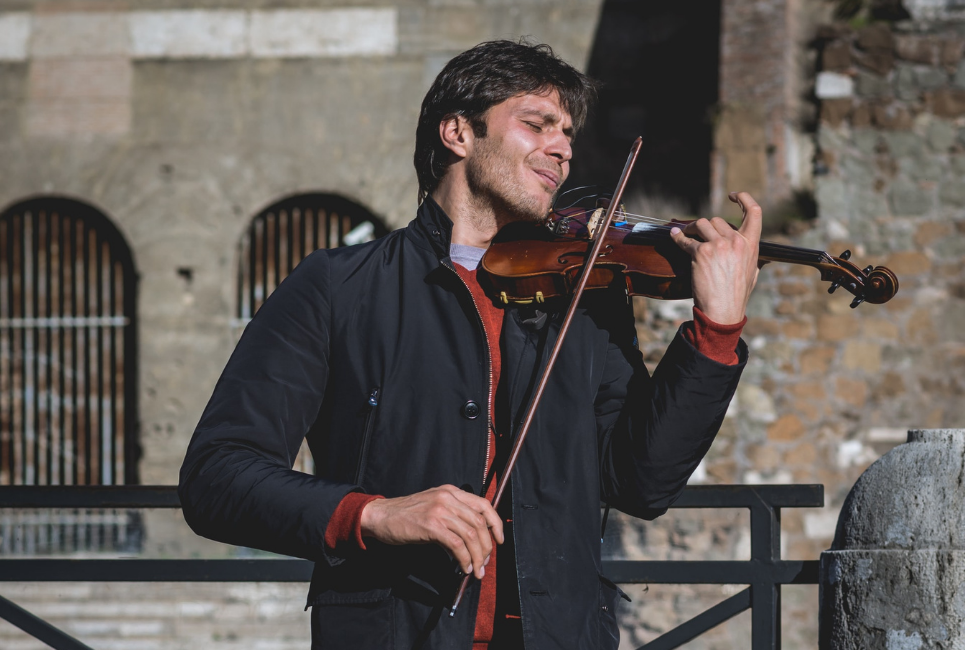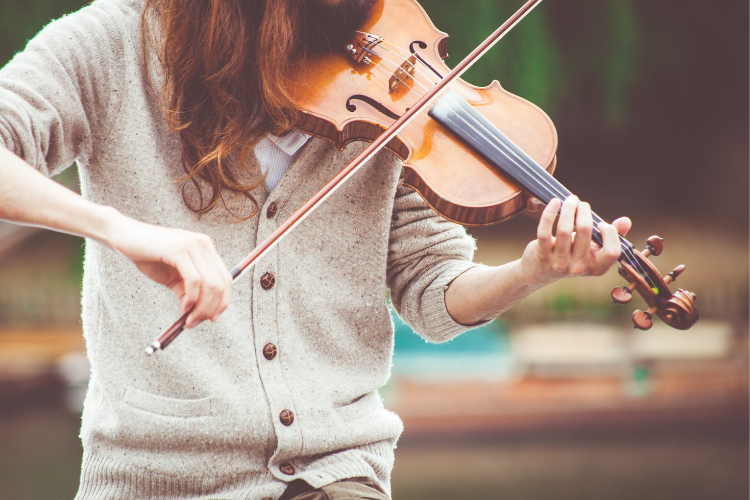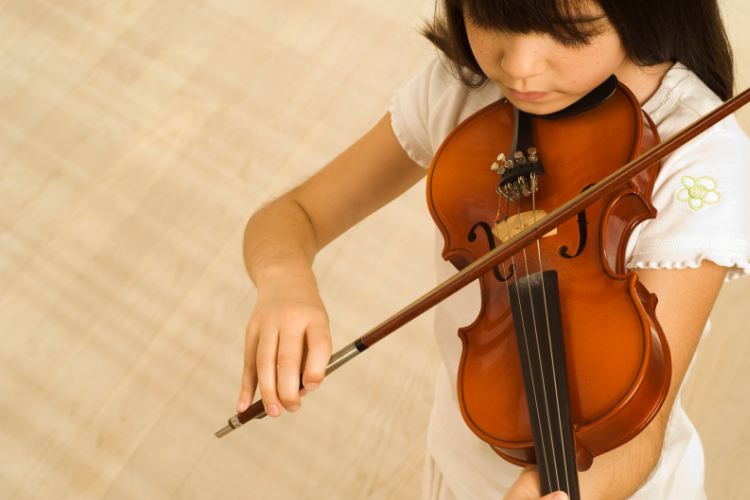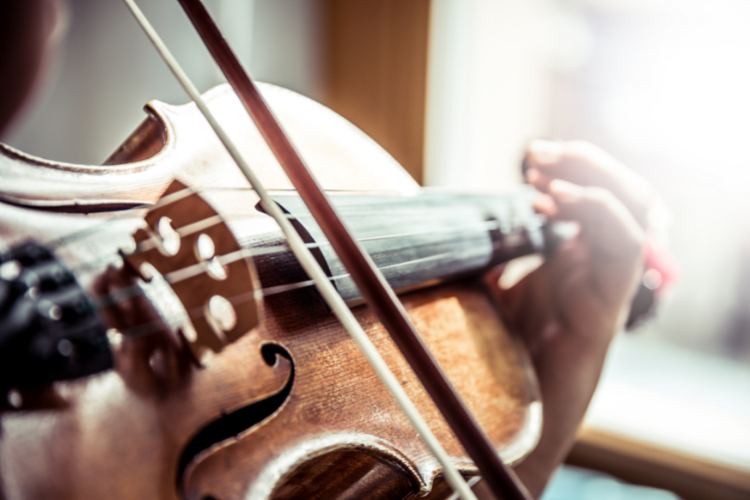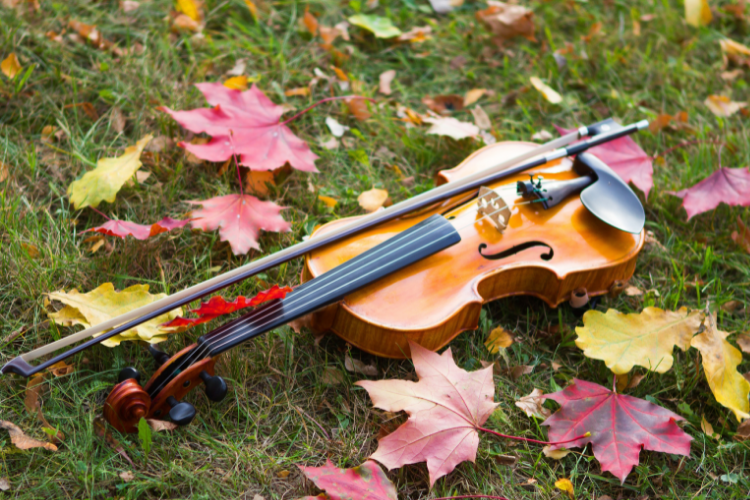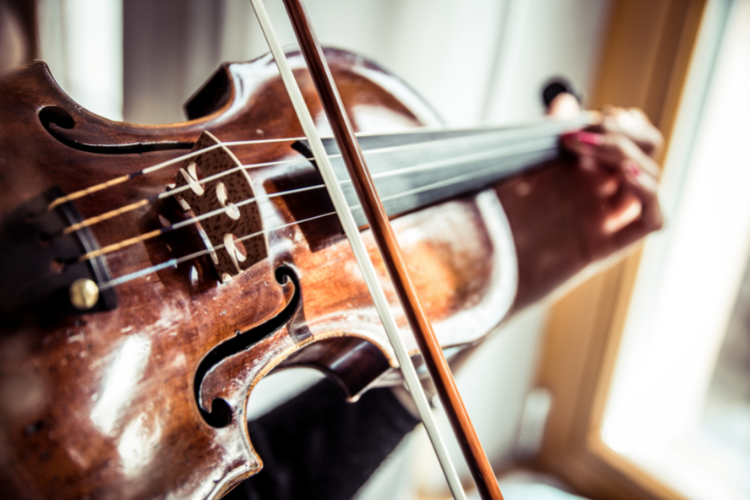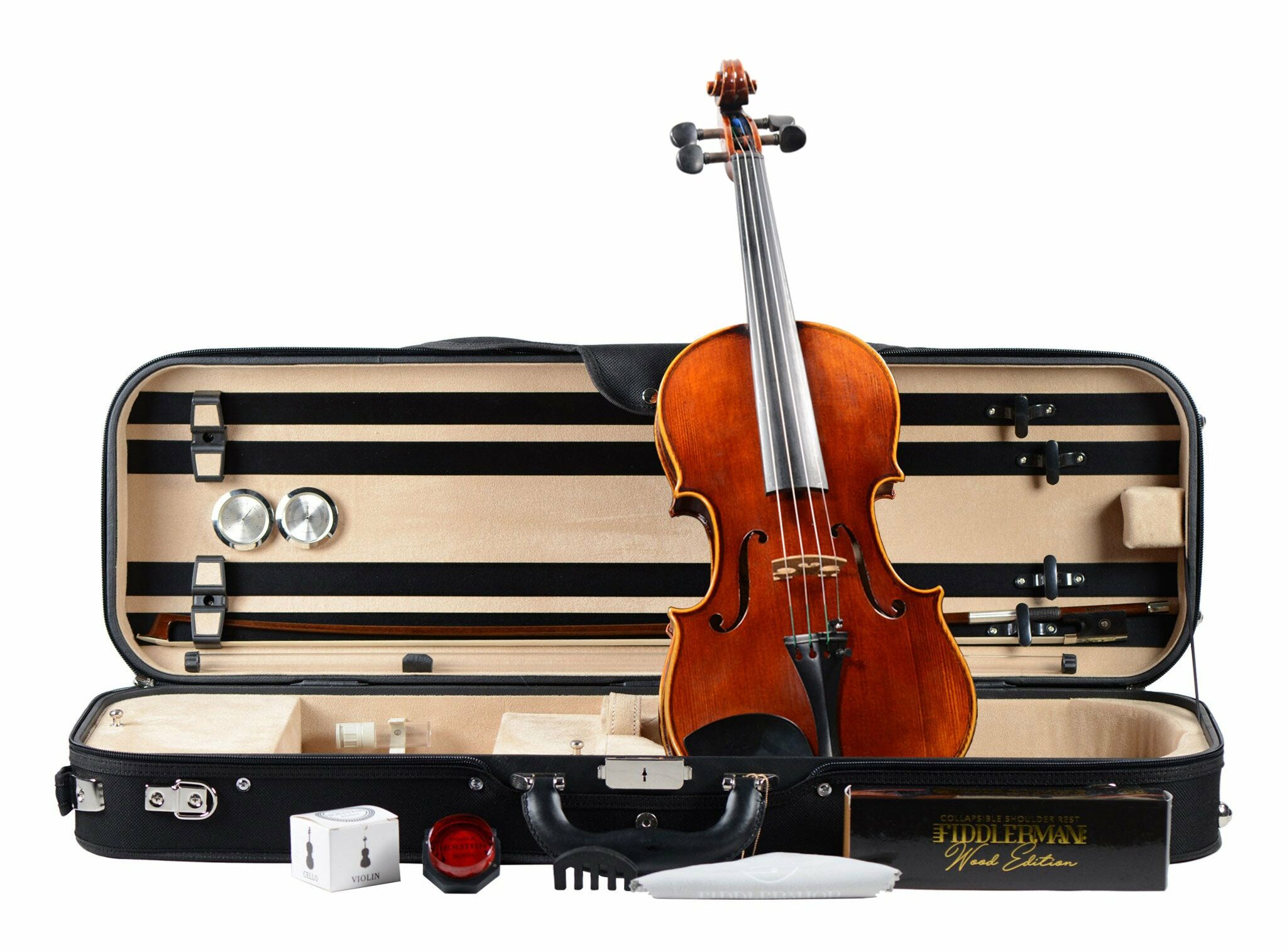- Best Fretted Violins Guide - May 31, 2022
- Best Yamaha Violins Brand Guide - April 13, 2022
- An Honest Mendini MV300 Review - March 31, 2022
It is a wonderful thing that you are learning to play the violin! You can learn much more about yourself and life from learning to play a musical instrument than you might expect, especially if that instrument is the violin.
Now, the first step is: where do you find one? What should you look for? It can be a dizzying experience, so hopefully, this guide will be able to give you some starting ideas and clear up common misconceptions.
Price
The first consideration many people have is price – how much will it cost? The answer is, you can spend as little as you like. You can find the cheapest violins on Amazon for under $30. Score, right? Not exactly. Yes, you can spend as little as you like – but you get what you pay for.
If you look at these cheap instruments the wrong way, they have a good chance of breaking irreparably. Jokes aside, a more common scenario may be that they just are unusable – maybe upon taking it out of the box and tuning it up, the bridge snaps, and the soundpost falls in.
These instruments are punched out by machines and slapped together. While that isn’t necessarily a guarantee they are going to sound bad, they are meant to only exist as “violins” so that they can sell on the internet for people who want to spend as little as possible.
If you’re looking just to try something out, perhaps renting is better for you. Let’s talk about buying now and renting in a minute.
Buying
So at what point do violins cross over from garbage to usable? Is there a dollar amount that is a hard line? Despite what many people will tell you online, the real answer is no.
There is not a set dollar amount that separates bad instruments from good instruments. Those cheap violins sometimes sell for hundreds of dollars, only to break within a week. On the other hand, you may find nice-sounding violins at ragtag music stores selling for hundreds of dollars less than what they sound to be worth.
So, what should you expect to spend? There’s no good answer to this. The more you spend, the more quality instruments you will be able to choose from.
Price does not necessarily completely correlate with quality, sometimes instruments are worth a lot because the owner paid that much for them, but that doesn’t mean they sound better than a cheaper instrument. Instead, you should consider your own financial situation as well as what category of learner you fit into.
Since everyone’s situation is different, here are a few different types of people who might be reading this article:
The Composer
He’s writing a piece for violin, and he’s never written for violin before. He wants to try some extended techniques on the violin to see how they would sound. It would be nice to have a violin in his large collection of instruments, but odds are he’s not going to play it much unless he needs to refer back to it for his music.
Advice: Don’t spend a lot of money. It’s OK to buy something that you know maybe won’t last as long as something nicer because you’re not going to need this instrument every day, and you have no aspirations to become a violinist. You just want to be able to understand the mechanics of the instrument.
The Toe Dipper
She’s always been intrigued by the violin but never had the courage to pursue it until now. She’s not sure if she will like it or not – she just wants to get a taste. Maybe she will stick with it. Maybe she won’t. A busy work and life schedule means that unless it’s really providing her a lot of enjoyment, she’s not going to pursue it as a hobby.
Advice: Again, don’t spend a lot of money. Try to find something that isn’t going to break in two seconds, but don’t break the bank. If you become serious about playing and taking lessons, you can upgrade later down the line. If not, then no problem – you didn’t incur a great financial loss.
The Kid
Mom wants him to take violin lessons at the local music store. He’s 7 years old, very excited, and, unfortunately, often clumsy.
Advice: If there’s a risk your child is going to break the instrument, the obvious answer is don’t spend money you can’t afford to buy again if the instrument breaks. Children are masterminds at finding new and inventive ways to break delicate stringed instruments.
You should teach your child, as his teacher will, to respect instruments as living things and pieces of art. But mistakes happen. Suppose your child continues to take the violin seriously. In that case, he will need to upgrade anyway, because violins come in different sizes, and depending on how fast he grows he may need a new sized instrument soon.
The Late Bloomer: All her life, she wanted to play the violin. She never got the chance to. Now that she’s retired, she wants to explore it – for fun, of course, but she is going to take it seriously.
Advice: You will want to find something of a certain quality that will not break immediately and an instrument you will grow into. If you’re going to take it seriously, at the very least your instrument should behave like a normal instrument does – it should be easy to play and not cause you any stress.
There’s no set dollar amount you should look within. You may find a quality instrument from a friend willing to give it away for $100. You could also find a very poor-quality violin that will break immediately for $500.
Yes, instruments can cost thousands of dollars, but you shouldn’t feel like your first instrument should be worth several thousand dollars – in fact, it shouldn’t.
It’s better to learn on an instrument that you don’t feel like you have to worry about constantly breaking – everyone makes mistakes and you don’t want to lose thousands of dollars when you make a common mistake.
Price is mentioned first in this article since it is the most popular concern of most people, but many more considerations are discussed later.
Bottom line for price: Everyone will make mistakes with their first violin. You may drop it, figuring out how to hold it, or you may forget it in the car on a cold night. If you take playing the violin seriously, then you will need an upgrade at some point anyway. If you are buying the instrument for a child, they will need an upgrade as they grow anyway.
Don’t go into debt spending money on your first violin, and don’t spend enough to where it would be a huge financial loss if something happened to it.
If you are a billionaire (please contact the author as he would like to teach you how to play violin), feel free to spend as much as you want, knowing that you can afford any mistakes that might occur.
But: while having bad equipment will make it harder to learn and play, as a beginner having the world’s best violin won’t make it easier.
You won’t make more progress on a top-tier instrument versus a “just acceptable” instrument – your instrument should not hold you back in any way, but as long as it doesn’t then, there’s no benefit from having a nicer one than that as a beginner.
Side note: you may have heard that violins can cost millions of dollars. Yes, this is true. Most professional musicians have violins that could be upwards of tens or hundreds of thousands of dollars.
Violin bows can also cost that much and more. But no, not all violins are thousands of dollars, and this shouldn’t be a deterrent for you to begin searching for an instrument.
Renting
There are a few benefits to renting: if you’re not sure playing the violin is for you, for example. The Composer and The Toe Dipper may benefit very well from renting a violin, as they may not need it again after he writes his piece and she figures out she doesn’t have enough time in her life to invest it in learning.
The Kid’s parents may find a rental agreement very advantageous if it includes insurance or a protection plan, meaning that if he breaks it, replacement or repair is part of the monthly fee.
The second benefit to renting is that you may be able to get a much nicer violin than what you would be comfortable paying for at the start. Most rental agreements are in the $30-40 a month range, and many of these violins at this rate are of a nicer quality than you might find within your purchasing budget, depending on what your budget is.
With the added benefits of insurance plans, many people may find that renting is the best option. However, if you end up falling in love with your violin and wanting to buy it, you will have to ask what the price is of the instrument and how feasible it is of you to afford it – that is, if the music store is even willing to sell it.
Next Considerations
What Size?
Violins come in different sizes. If you are a grown adult, chances are you need a full size violin (4/4). Some short adult women use 7/8ths size violins because they find them easier to play. Violin making has existed for hundreds of years, and there is no exact measurement of what a full size violin is – there is just a general idea.
If you are not an adult, then you should consider what size of violin you need. The way to determine what size of violin you need is by taking any violin and putting it under your chin as if you are going to play, then taking your left hand and putting it on the scroll, the end of the violin. There should be a bend in your arm.
If you are struggling to reach the scroll, then you need a smaller violin. If there is too much bend in your arm, then maybe you are ready for a larger size violin. You should get the largest violin you can handle without your arm stretching too far. This is because there are far more quality violins in full size and 7/8ths than there are smaller sizes.
Where to Look
Your first resource should always be your teacher. If you want to take the violin seriously, you should get a teacher. Yes, there are many tutorials online about how to play the violin. Yes, there are many people online who will say that you don’t need a teacher. But ultimately, having a teacher is better than not having a teacher.
For one, it is easy to injure yourself playing the violin. Your technique has to be good, and you can’t have any tension anywhere in your body, or you may end up with arthritis, other joint problems, or carpal tunnel. Many people have these illnesses because they learned how to play incorrectly because they did not have teachers available.
Asking people online for advice is one thing; recording a video of yourself playing and asking for posture feedback is another. Neither of these things comes anywhere close to having a knowledgeable person in front of you who can easily spot problems before they occur, someone who you can ask any question to and get an immediate answer, not just about posture and technique but about the entire learning experience.
All that to say: your teacher should be your first resource on where to find a violin. He will be able to recommend violin shops to you or music stores that are reputable.
He will also be able to tell you if an instrument you find is worth the price or if it’s an overcharge. If you’re still looking for a teacher, then you should Google “violin shops” and go visit one.
If you don’t live near a violin shop or fine-stringed instrument store, then for a beginner, it might be OK to pick a general music store, assuming that at least someone there knows something about the violin.
But what if you want to look online? We’ll get to that. Right now, let’s assume you’re in the shop with a selection in front of you.
What to Look For
If you are touching a violin for the first time in the store, you will not be able to know how good it sounds if you don’t know how to play yet. But as a beginner, the sound of the violin is not the first thing you should look for. There is a long list of other considerations about the construction and quality of the instrument that should come first.
Unfortunately, there’s also no way that you will be able to spot these things by yourself if you have never played the violin before. That’s why it’s important to have a teacher or someone who plays the violin with you so that they can give you advice on if the instrument is good quality or not.
This may not be the answer you’re looking for – but it is the honest one. There is no shame in asking for advice from a trusted source, as with any major purchase.
If your teacher is not with you, focus on only two things: how easy the instrument is to tune and how high the strings are from the fingerboard. You should look for these things even if your teacher is with you, but if you’re flying blind, you will have these two ideas as starting points.
Tuning – You will have to tune your violin strings every time you play. The violin has four strings that are adjustable in pitch. They have to be at a certain pitch for you to play in tune. If you are not able to tune your violin, then maybe it’s best not to have that violin. How would you know if the violin is easy to tune?
There are two different ways violins can be tuned: pegs and fine tuners. The pegs are the four screw-like things sticking out from the top of the violin. Fine tuners can be found at the top of the tailpiece. Most professional violinists do not have fine tuners for the lower three strings but have one for the highest pitched string, the E string.
However, as a vast generalization, most beginner violins will include fine tuners on all four strings, because pegs can be tricky to learn how to use at first. The problem with the fine tuners is that sometimes they get stuck, so you can’t tune your violin as easily.
So when you are looking at a violin for the first time, you should make sure that you are able to use the fine tuners – don’t worry about the pegs yet. Ask the salesman to show you how to turn the fine tuners of the violin. Try turning them – if they are too stiff and it hurts your fingers to turn them, perhaps it’s not a good idea for you to get that violin.
Yes, there are ways to replace the tailpiece and/or the fine tuners. But this is not something you should attempt as a beginner. In fact, beginner model violins may not fare well if this is tried. However, this is just a guideline – if you find a violin that you really like, but the fine tuners are too stiff to turn easily, ask if they can be replaced or better yet, ask your teacher for his advice.
String height – when playing the violin, you need to press down the strings onto the fingerboard. You should only press as much as it needs to let the string be contacting completely with the fingerboard – don’t press any more than that or grip your hand tightly, as you will end up with problems later on.
The distance between the strings and the fingerboard should not be so high that it hurts to press down. Obviously, nearing the end of the fingerboard the strings become higher, and on every violin harder to press down.
Don’t worry about that – only try to press down as far as your four fingers go when your index finger is near the top of the fingerboard (closest to the pegs).
If you’ve never played a stringed instrument before, you may not be used to the feeling of the strings digging into your fingers. It may hurt at first, and some people develop calluses from this. However, string height is a different issue from this.
If your strings are too high, they will dig into your skin, but also your fingers and hand will suffer, as you will have to grip the fingerboard tighter and press down harder to make sure you are playing the note with a clear tone. In other words, expect your fingers to hurt if you have never played the violin before – but how can you tell when the issue is the string height and not just your fingers getting used to it? It’s best to try a few different violins, and then you will be able to notice a difference.
One violin may have strings very high that require a lot of pressing down, while another may have strings very close to the fingerboard. If you try multiple instruments, you will be able to notice the difference. Again, asking your teacher or a violinist friend to try the instrument will ensure that you’re on target.
As a side note – use good judgment on the level of discomfort in your hand. It’s safe to say that the discomfort of the strings on your fingers shouldn’t last several months into playing. If you’re experiencing muscular pain, it’s best to stop earlier and ask your teacher for help before it’s too late.
These are maybe the most important two things you can consider. If you’re not able to tune your violin easily, you will have a very frustrating experience that will not make learning easy, and you may decide it’s not worth it and quit.
If your strings are too high, you will most certainly be pressing too hard and having too much tension in your hand, which will hurt at the very least, and worst case scenario leave you with an injury.
Online Purchasing
Should you order a violin online? The answer is probably no unless you live in a remote area near no music stores and you would not be able to get a violin otherwise. Even though you won’t know everything to look for as a beginner, you won’t be able to even check the two issues just talked about.
If you have to order an instrument online as a last resort, get as many photos of the instrument as you can. Perhaps send them to a violin friend or post them in a message board to get advice. Be mindful of your budget, and be aware that, if packed improperly, a violin may damage during shipping.
It is best to, at the very least, loosen strings before shipping, but the better answer is to take the bridge down entirely. This could be a problem because if you’re a beginner, you shouldn’t try to set the violin bridge up yourself – you could cause permanent damage to your instrument.
Again, these are not fun and easy answers, but they are the best advice for your instrument’s well being.
The exception to this is if you’re buying an instrument from an individual who played the violin. Maybe they are trying to buy an upgrade themselves and are looking to sell their beginner violin, or maybe they are retiring from playing and are looking to pass their instrument on to the next generation of learners.
Either way, they will be able to answer the questions about if the fine tuners are in good condition and if the strings are too high – because they have been playing on it themselves! Though, be careful if they’re selling it because the fine tuners are too stiff or the strings are too high!
You won’t find individual sellers on Amazon, but you might on places like Craigslist and Facebook Marketplace. Remember, just because they’re an individual selling a violin doesn’t mean they actually played it – they could be as clueless as anyone who has never seen one before.
To recap: it’s best to see the instrument in person along with your teacher or a violinist. If this is not possible, use your best judgment about how easily the fine tuners move.
If you have to buy the violin online, then hopefully, someone can help you set it up once it arrives. Don’t be shy to email anyone who you know that plays the violin, or if a local university has a violin teacher. All violinists love to help other people start playing!
Student Violin Recommendations
There are a handful of trusted violin brands that many students may play, like Eastman, Stentor, Fiddlerman, and Kennedy Violins, if you are looking for a used violin these are ones to keep an eye for. But in general, a string instrument shop will have the best quality violins regardless of label.
There are a handful of trusted online retailers and renters of violins like Fiddlershop, Shar Music, and Violin Outlet that sell both brand new and used instruments. These guys specialize in selling orchestral string instruments and have been doing it for years. They’ve perfected their shipping and packaging methods so your violin will get to you in one piece, fully set up, just tune it and play. While this won’t replace buying a violin in person it can be a great starting place for a student who doesn’t have access to a music store. I’ve chosen violins that will get a student through the first few stages, two to three years or so. Some of these choices will last a student much longer and help them advance quicker.
Top Pick – Fiddlerman Concert
Fiddlershop is one the most trusted online retailers for violins and other stringed instruments. I trust them to always deliver a carefully packaged violin to my doorstep. If something happens in transit, they will happily correct the mistake and then some. The Fiddlerman Concert is my favorite student violin because of its tone and playability for a new student. New students start off simply playing open strings, then Twinkle Twinkle, and finally basic scales. Students may spend a lot of time in these areas. Still, eventually, they will start playing more complex selections and move through their method books. This violin will move right along with them, giving them room to grow and advance before needing an upgrade.
Its made from quality spruce and maple tonewoods that have been dried for at least 6 years. The fingerboard is 100% ebony, as are the pegs and fittings. The tailpiece is similar to a Wittner tailpiece made from carbon composite with 4 fine tuners. This violin comes with Fiddlerman Strings, similar to Dominants in tone and response. They are some of my favorite student strings. The hand-rubbed varnish finishes out the construction of this violin. The outfit includes an upgraded case, carbon fiber bow, shoulder rest, rosin, practice mute, and digital tuner. It’s also available in sizes 1/8 to full, covering a wide range of beginning students.
Pros
- The tone is more powerful and nuanced compared to other student violins.
- Comes with quality accessories that will last a long time
- The string choice is an upgraded student standard which is great.
- Will last a student longer than cheaper alternatives
- Comes from a trusted retailer that fully inspects and hands up each instrument.
Cons
- More expensive than other options
Budget – CVN 500
The CVN 500 is my budget pick from Amazon. I’m not the biggest fan of Cecilio instruments, having started on one, but they are cheap and will get you through roughly the first year or so. Suppose you don’t have any rental options around. In that case, this is a great option to see if you enjoy playing the violin without breaking the bank. This is a factory violin, so don’t expect the best setup or a setup at all and don’t expect the best materials. Still, this violin meets the basic criteria with solid spruce and maple tonewoods, ebony fingerboard and fittings, and D’Addario Prelude strings. With a case, bow, rosin, shoulder rest, and lesson book, you will have everything you need to get started.
Suppose this violin comes with the bridge down. In that case, it will need to be taken in for a setup, as a new violinist shouldn’t be setting up the bridge themselves. This will add to the overall cost, and at that point, you should put that money towards a better overall starter violin.
Pros
- A well-known beginner violin
- Made with decent tonewoods and material
- Comes with everything you need to get started; I recommend getting a different bow right away.
- Inexpensive
Cons
- Closer to a violin-shaped object than a student violin
- Won’t let last more than a year or two
- Accessories are of poor quality
- Small case
Step Up – Franz Hoffmann® Concert Violin
The Franz Hoffmann® Concert Violin is my pick as step-up violin. This violin sits comfortably in the range of affordability and quality. It’s from the well-known orchestral string dealer Shar Music based out of Michigan. They are known for offering rentals to many different schools in the US. This violin features maple and spruce tonewoods with ebony fittings and a composite tailpiece with built-in fine tuners. The outfit is pretty basic with a triangle case, mini rosin, and a basic but quality bow. You’ll still need to purchase a shoulder rest and tuner. This violin can also be rented easily online and shipped to any state in the US except for Hawaii and Alaska. However, I don’t recommend renting this violin as the rent-to-own program will cost you more than double the actual cost of the instrument and accessories. Instead, purchase this one outright only.
Pros
- Inexpensive but great starter violin
- Comes with basic accessories
- Loved by teachers in the US
- From well known orchestral string dealers
- Available in 1/4 to full size
Cons
- Only ships to the continental US
- The rental program has poor terms
- Doesn’t come with basics like a shoulder rest
Expensive – Cremona SV-800
The Cremona SV-800 Premier Artist Violin is a gorgeous step-up violin that will suit a beginner through intermediate player very well. If you purchased a cheaper violin off Amazon, this would be an excellent upgrade. Cremona makes several quality orchestral string instruments and parts. Its made from a solid spruce top and well flamed solid maple back, which are entirely hand-carved. The fittings are boxwood hill style which is a nice change from the traditional ebony and suits the finish of this violin well. The fingerboard is 100% ebony and comes strung with Dominant strings. Along with a LaSalle LB-40 Brazilwood bow and a plush oblong case, you will have all the basics. You are getting a much more expensive instrument for this price, and therefore, purchasing separate accessories is considered normal. I recommend a Kun or Fiddlerman carbon fiber shoulder rest and some rosin. My favorite is Kaplan Dark or Magic Rosin.
Pros
- High-quality instrument that will please a student to intermediate player
- Upgrade bow and case
- Hand-carved tonewoods with antiqued varnish
- Comes set up and ready to play
Cons
- Expensive
- Only bare basic accessoires
- Comes with one fine tuner, not 4. Extras will need to be bought and installed either by yourself, a teacher, or a luthier.
Prodigy – Fiddlerman Soloist Violin
Suppose you or your student showcases considerable affinity or ability for the violin. In that case, the Fiddlerman Soloist Violin is an instrument to check out. While this is definitely an intermediate violin, if an absolute beginner has the confidence in their interest in the violin and the budget, I would wholeheartedly recommend this pick, with a few special asks of the luthiers at Fiddlershop. This violin is made from hand-carved aged select spruce and maple tonewoods with hand-rubbed oil varnish and ebony fittings and fingerboard. The strings are luthier picked to bring out the most in each violin. The outfit includes a carbon fiber bow, wood shoulder rest, premium rosin, practice mute, and tuner. Overall this violin will stay with you for years as you learn your scales to Bach and maybe even Paganini if you dare.
Pros
- High-quality violin that will stand up to years of use
- Comes completely set up and ready to play
- Top-class customer service to get you the best instrument
- A full outfit with everything you need to get started
Cons
- Expensive
- Will need to special request 4 fine tuners.
Here Are Some Common Questions You Might Have Left
Answer: Professionals generally don’t use “brands” of violin – quality violins do not come in brands, they are made by individual makers who work independently. It’s not the same thing like guitars or pianos. Someone may encourage you that a particular “brand” of violin is the way to go – this may be so for a beginner instrument.
Still, it’s important to remember that professionals are not using “brands” of violins, so don’t let anyone tell you otherwise. Starting out, don’t worry about buying a “brand” of a violin like you would a car or a computer. As long as the fine tuners turn and the strings aren’t too high, consider it a match for your first violin.
Answer: Many people try to say they have a “Stradivarius violin.” They mean to say that they own an instrument crafted by Antonio Stradivari (1644-1737), perhaps the most famous violin maker of all time. Odds are, their instrument is not a Stradivarius. If it has a printed label inside that says “Stradivarius,” – it’s not a Stradivarius violin.
Because of Antonio Stradivari’s popularity, many people copied the designs and exact measurements of his violins to sell as copies. This does not mean that they were made by him – it means they are copies of things he made. Think of it as having a print of the Mona Lisa or another famous painting.
Do you have the painting? You have a copy of the painting while the real one hangs in the Louvre. You might have a relative that insists on having a Stradivarius violin. This is probably not the case – it would be extremely, overwhelmingly rare for this to be the case, so much so that it’s basically impossible.
It is estimated that the Stradivari workshop produced around 960 violins, and about 500 survived, and the vast majority of these have been cataloged. You shouldn’t be duped into spending lots of money on an instrument that says it’s a “Stradivarius violin,” when in fact it’s probably a copy.
If your uncle insists the dusty instrument in his closet is a Stradivarius, book an appointment with a professional violin appraiser and get the instrument looked at. You can find appraisers in any major city, and some may even be kind enough to tell you from a picture.
Answer: As previously stated, violins don’t really come in brands. Some companies create student instruments, but for your first violin, it really, really doesn’t matter. What matters is if the fine tuners turn and the strings don’t hurt your fingers.
You can go down a rabbit hole of searching for “the best violin for beginners” but it is ultimately going to be a big waste of time and effort. Again, not a popular answer, but the honest answer.
Answer: This depends on how big you are as a person. Scroll up to read about how to see what size violin you need, but basically: if when you’re holding the violin under your chin you can’t reach the scroll and grab it comfortably with your whole hand, you need a smaller violin.
If you are able to do this extremely easily, then consider getting a bigger violin. Again, there’s no way to do this without seeing an instrument in person, which is why it’s vitally important to not just buy anything that looks good online.
Answer: You will need a shoulder rest, a bow, rosin, and a case! Your violin teacher will be able to show you these things, or the music store salesman will. You may want to get a tuner and a music stand too, but these aren’t essential things to have yet – let your teacher instruct you what to do. If you have extra money and would like to buy accessories, go for it.
But other than having a shoulder rest, a bow, rosin, and a case, nothing else is an absolute necessity to start, despite what a salesman might tell you.
Closing Thoughts
Learning to play the violin is a special experience. It can provide you with many hours of enjoyment and give you a purpose in life. You might get frustrated by learning to play – one day, you’ll feel very accomplished, and the next, you’ll play the same way but wish it was better.
This is the common experience of learning to play, and you should know that everyone who has ever played felt this way. Look at any famous violinist on YouTube – they all started the same way you are, with the same frustrations. Don’t worry about how fast you’re making progress or if you’ll ever sound the way you want to.
As long as you have a passion for playing and enjoy it, you don’t need to worry about anything else.
Ready to learn more? Check out:

